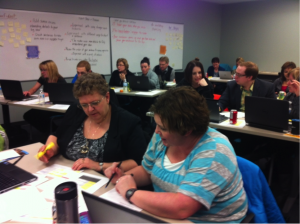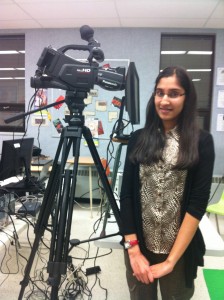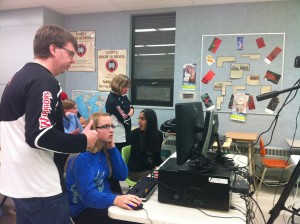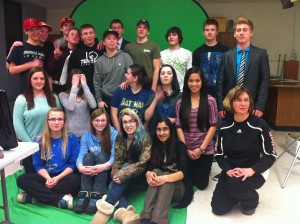by Michelle Sanderson
Cross-posted at Indigenous Education
I recently read, an article about Paul Martin as printed in May 15, 2013, in the Globe & Mail (Toronto, Canada), Aboriginal education vexes Martin, Canada., and I invite you all to take a good critical read of this article. To summarize, Martin is celebrated for putting some of his own money into projects aimed at helping Indigenous people. I bring indigenous history and an anti-racist, anti-colonial, and critical lens to the article in understanding the reasons and manner with which Mr. Martin concentrates his efforts to alleviate the suffering and attempting to address the problems experienced by Aboriginal people.
After reading the article, I found that Martin names a lot of the problems indigenous people face when being a member of an oppressed group in Canada. These are touted on two different areas in the article, some of the problems that he named quite uncritically, I might add, are half of the homes have single parent families, half of the students who are in school are in foster care, high unemployment rates, Fetal Alcohol Syndrome, weak literacy/low literacy rates, lack of role models, reserves are economic dead ends, poor housing, educational inequalities, 25% – 40% less funding per student for primary students in schools, and last but not least, gangs, crime and violence.
That list is a little overwhelming, maybe even daunting. However; the problem with the article, is that the reader is left to their own devices to make sense of these sad and grim statistics. Without a critical view of what all of this means, the article in itself, serves to do a dis-service to indigenous people. I commend Martin on putting his money where his mouth is, but, at the same time, I worry, that without a critical understanding of the statistics he’s touted, that he just may be very well be perpetrating stereotypes about the very people he’s trying to help. We must ever be conscious of the brush of stereotyping.
As many elders and spiritual elders explain, you can’t solve a problem with the same mindset that created it. If you know your Canadian history, then you’ll be aware of how our early indigenous ancestors experienced the newcomers. The newcomers saw our early indigenous ancestors as needing help, that there was something wrong with them, that they didn’t have something, that should be given to them, that they, the oppressors could provide. This deficit thinking led to some very profound mindsets, or strategies, which painted indigenous people with negative connotations. Without a critical understanding of these multi-faceted problems called into attention, we may blame the victim. We can avoid that by educating ourselves and understanding our nation’s true history, which isn’t pretty.
It is this very Canadian history, which is intertwined with colonialism, racism, which in large, lead to where First Nations people are today. Policies like residential schools to “take the Indian out of the child” were a real part of our history and it’s this, our shared history, which has material consequences in today’s society. Unrealized treaty promises lead to economic detriment to First Nations farmers. There were untold opportunity, for the early settlers, and true, like the Canadian national story tells, there were difficult times for those settlers. However; those settlers had opportunity and privilege which was systematically denied to the early First Nations farmers. Time and time again tales of withheld impliments, denied access to the market are told about our First Nations farmers. It’s sad to hear about it, but as well, there are many tales of lost lands, which were then placed into the hands of the newcomers or settlers. These are the stories that are untold in public education, deliberatly or not, which need to be told. It is these events, which have lead to the material consequences of poverty for generations for some and wealth for others. Some are still benefitting off the wealth of that very land today. So, although it may seem like it’s all in the past, there are true material consequences to the policies and laws that were put into place in the early 1900′s to privilege some and to deny others. This, in short, is the definition of racism. In order to move forward, we need to acknowledge our dark past. There’s no moving forward without the validation of the truth. There are still tons of residual trauma connected with unrealized treaty promises, residential schools and policies like the Indian Act. The last residential school, here in Saskatchewan, was closed only in the 90′s. It’s not far enough in our distant past to relay the racism as a past tense, as in it happens no more. These same policies are at the root of today’s lived oppression, poverty and intergenerational trauma which have affected today’s indigenous people. Many of us both indigenous and settler, are trying very hard to walk a new path, and reconnect with wellness, through a variety of ways, and it’s important if we’re going to walk this road in the manner our indigenous ancestors intended, hand in hand, sharing all economic opportunities and the land and seeing each other as humans beings, as cousins, that we indigenous and settlers have to understand our dark past to meet our bright future together.
Regardless of thestatistics, or the problems which are said to be “plaguing” First Nations, without fully understanding the situation, it is extremely detrimental to the communities you are working in to not understand our collective histories. More importantly, when working with oppressed groups, such as Canada’s First Nations, it’s important to remember that the indigenous people did not arrive at such atrocities by themselves. These problems and statistics are real material consequences which were, and are, arrived at through policies, procedures and implementations of real laws aimed at marginalizing the First Nations people.
Some of the laws aren’t too far in the distant past. In this modern day and age, we can see differences in funding, as much as 13,000.00 per child, in on- reserve schools, compared to provincial schools. This only serves to ensure a lower quality of education, ensure less teacher time for indigenous students on reserve than in the city. Martin is right when he talks about our indigenous students being second class. And the policies just keep coming! With the education act being pushed through parliament with the omnibus bills, we see more legislation coming to provide even less to indigenous students on-reserve.
One challenge I would put to Martin, is to look at First Nations in a new way, as a group of oppressed people who do have the role models in their communities, who do care about their children’s education and well being, and indeed many First Nations people do work, are sober, are educated, pay taxes and deserve to be treated and talked about with dignity when and where the subject of indigenous people exists, in education, in mainstream, in the economy and even in the media. It is also equally important to realize that for those who are suffering ongoing lived oppression, that they didn’t quite get there by themselves and that Canada itself has a long and on-going violent colonial history toward Aboriginal people and would do well to acknowledge its role in the predicament that First Nations and Metis students find themselves in.
I’ve included some links and citations to some articles, which delve into these multi-faceted issues further. I hope my article/blog sparks some conversations, to change the old way of seeing and look through the world with new critically awakened eyesight. I applaud Mr. Martin and I hope that he continues work for the wellness of all humankind and I encourage him to further educate himself as to how to better “become an ally.”
http://www.theglobeandmail.com/commentary/aboriginal-education-vexes-canada-and-paul-martin/article11912835/
The Hawthorn Report (online)
http://www.collectionscanada.gc.ca/webarchives/20071126042754/http://www.ainc-inac.gc.ca/pr/pub/srvy/sci1_e.pdf
Cardinal, Harold. The Unjust Society. 2nd ed. Vancouver: Douglas & MacIntyre, 1999. 140.
Lawrence, Bonita. “Gender, Race, and the Regulation of Native Identity in Canada and the United States: An Overview.” Hypatia. 18:2. 2003. 3.1
Mullin, Jessica. “Opinion Shale-gas exploration debate exposes intersecting issues of race and colonialism.” October 18, 2013 Miramichi Online
 The Living Sky School Division set a goal two years ago to support the enhancement of student writing across all grades. Many schools have also established their own writing school goal. Professional development activities, regular and focussed teacher conversations about writing, and the implementation of a variety of strategies have all been some of the ways teachers have sought to improve their instruction and students’ achievement. In an effort to provide teachers and students with some specific feedback from a division perspective, a small sample of student writing from grades 3, 6, 9, and 12 is collected every year from all schools. Teachers from each of these grades meet once a year (May) to collaboratively score hundreds of pieces of students’ writing from across the school division. Every student’s work is assessed by two different teachers using a four point rubric. This specific feedback is returned to each student for reflection. Data collected from the collaborative scoring days is collated and returned to schools to guide planning for the upcoming year. Division wide data is organized to provide a picture of how well our students are achieving curriculum expectations for writing and to guide supports for the upcoming year.
The Living Sky School Division set a goal two years ago to support the enhancement of student writing across all grades. Many schools have also established their own writing school goal. Professional development activities, regular and focussed teacher conversations about writing, and the implementation of a variety of strategies have all been some of the ways teachers have sought to improve their instruction and students’ achievement. In an effort to provide teachers and students with some specific feedback from a division perspective, a small sample of student writing from grades 3, 6, 9, and 12 is collected every year from all schools. Teachers from each of these grades meet once a year (May) to collaboratively score hundreds of pieces of students’ writing from across the school division. Every student’s work is assessed by two different teachers using a four point rubric. This specific feedback is returned to each student for reflection. Data collected from the collaborative scoring days is collated and returned to schools to guide planning for the upcoming year. Division wide data is organized to provide a picture of how well our students are achieving curriculum expectations for writing and to guide supports for the upcoming year.





